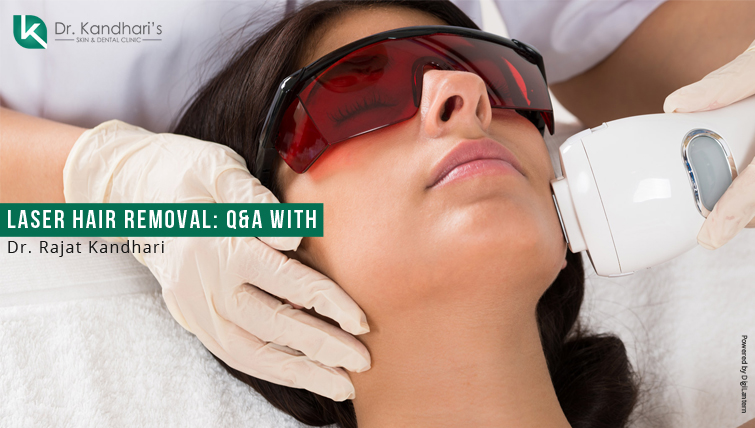Laser Hair Removal
Q. 1 WHAT ARE THE AREAS FOR LASER HAIR REMOVAL (LHR)?
Dr. Rajat Kandhari: The most commonly requested areas for laser hair removal in women are facial hair, particularly the upper lip and chin area, sometimes even the jawline. Further, lower limbs and underarms and bikini line are common areas which are treated for LHR. The chest, back and the beard areas for shaping the beard are common in men.
Q. 2 WHAT’S THE BASIC MECHANISM OF LASER HAIR REDUCTION?
Dr. Rajat Kandhari: To put it simply – the laser beam uses a particular wavelength of light (in this case 810nm, emitted by an element called diode), this particular wavelength of light is best absorbed by pigment present in the hair (melanin, known as the absorbing chromophore). Melanin sort of catches the light well and confines the light into the hair shaft thereby resulting in heating of the shaft and eventual vaporisation. The light which is converted to heat is confined to the shaft. Although the skin also has melanin (acting as the competing chromophore), since the diode penetrates deep, the light directly goes to the hair and is not absorbed by the superficial skin. This process is called “selective photothermolysis” – selective because the melanin in the hair absorbs the lights and photo –thermo – lysis meaning the light gets converted to heat and destroys the hair.
Q. 3 IS AN IPL DIFFERENt FROM A LASER? DO THE RESULTS VARY?
Dr. Rajat Kandhari: Yes. IPL or intense pulse light is not a “real” laser, since it emits a broad spectrum of light in contrast to a laser which delivers a specific wavelength of light (commonly 810nm in case of a diode laser which is commonly used for LHR). The presence of a specific wavelength in a laser results in selective heating of the hair shaft and confinement of the heat to the target (being the hair shaft). In case of an IPL the light is absorbed by not only the hair but host of other elements in the skin, thereby making it non selective and at higher energies resulting in more chances of adverse effects such as burns. IPL is best reserved for superficial abnormalities and imperfections and is used as a photo-facial. Generally, IPL is used for some cosmetic dermatology treatments but laser is more effective when it comes to hair removal treatment.
Q. 4 ARE ELECTROLYSIS AND LASER HAIR REMOVAL TWO DIFFERENT TERMS?
Dr. Rajat Kandhari: However, both the terms describe different hair removal techniques, electrolysis has largely been discontinued by most people and in fact is literally considered obsolete now. Electrolysis involves treatment of one hair at a time, is painful, time consuming , requires unending and frequent sessions and is considered to lead to not only destruction of the hair but along with it the sebaceous gland as well leading to dry and lustreless skin in the area. The advent of LHR which is convenient, fast, covers large areas in one sitting it has become the obvious choice amongst doctors and patients alike. Electrolysis maybe best reserved for white hair.
Q. 5 ARE THERE ANY RISKS INVOLVED IN LASER HAIR REMOVAL?
Dr. Rajat Kandhari: Although LHR is a relatively safe treatment, few common side effects may occur even in the best of hands, superficial burns (when aggressive parameters are used) and acne breakouts may occur at times but typically settle within 5-7 days at most. There is no downtime, which means that patients can return to their routine as soon as the treatment is over. Diode laser has a long wavelength which penetrates deep and decreases chances of side effects as there is less absorption by the pigment in the superficial layer (competing chromophore).
Q. 6 IS THERE A SPECIFIC AGE LIMIT FOR LASER HAIR REMOVAL?
Dr. Rajat Kandhari: There is no consensus on this, although it is generally believed that a woman 2 years post menarche may consider LHR. Further, I believe that in younger individuals who are suffering from excessive hair growth due to an underlying disorder, proper counselling of the patient, the parents and consultation of an endocrinoligst is required after which LHR may be considered.
Q. 7 IS LASER HAIR REMOVAL PAINFUL?
Dr. Rajat Kandhari: Not really. Laser Hair removal causes minimal discomfort as compared to waxing. A numbing cream maybe applied before the procedure to minimise the discomfort. The discomfort decreases as the hair starts thinning down, so people with thick hair may experience more discomfort in the initial few sessions which only decreases with subsequent sessions.
Q. 8 DOES THE RADIATION CAUSE HARM IN SOME WAY?
Dr. Rajat Kandhari: As said earlier the light is essentially absorbed by the pigment and does not penetrate any deeper, thereby making LHR safe. Further laser light is non-ionizing and with the use of proper eye protection in skilled hands LHR is a relatively safe treatment if done by eminent skin specialist and does not pose other health risks. It in no way poses risks of cancer as well, which has been asked by many patients.
Make sure proper certified eye protection is used when using the laser close to the eye since few reports of damage to the eye exist when the laser has been used for eyebrow shaping.
Q. 9 DOES THIS HELP IN GETTING RID OF HAIR PERMANENTLY?
Dr. Rajat Kandhari: The initial sessions (6-8) are required to make the hair thin and sparse, further the time interval between hair growths substantially increases. After the initial phase, maintenance phases are required as and when the hair grows (typically ranging from 2-9 months, depending on the body part and amount of hair). If maintenance sessions are done in a proper manner a stage of “almost permanent” hair reduction is achieved in most individuals. Those who go through the initial phases and are regular with maintenance treatments are very satisfied.
